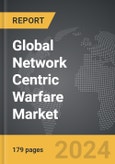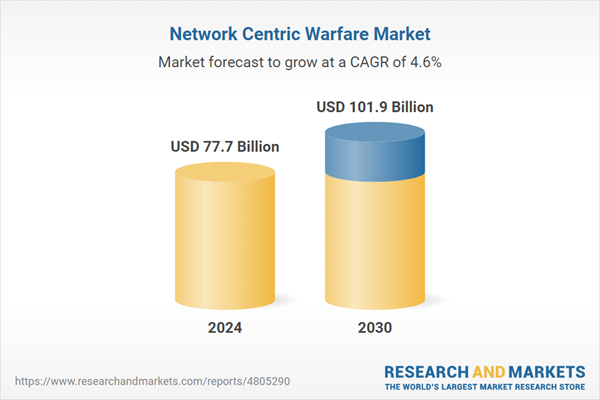Global Network Centric Warfare Market - Key Trends & Drivers Summarized
What Is Network Centric Warfare, and Why Is It Transforming Military Operations?
Network Centric Warfare (NCW) refers to a military strategy that leverages networked communications and information systems to enhance battlefield awareness, decision-making, and collaboration among forces. By integrating data from various sensors, platforms, and command systems, NCW allows for real-time information sharing, enabling coordinated actions and faster decision-making. This approach fundamentally changes how modern militaries operate, shifting from traditional hierarchical command structures to more decentralized, agile, and responsive operations. The seamless flow of information in NCW enables better situational awareness and faster responses to evolving threats, making it essential for contemporary defense strategies.How Is Network Centric Warfare Revolutionizing Military Capabilities?
Network Centric Warfare is revolutionizing military capabilities by improving communication, coordination, and decision-making across all branches of the armed forces. Through real-time data sharing and advanced communication networks, NCW enables commanders to have a comprehensive view of the battlefield, making informed decisions that can be quickly relayed to units on the ground, in the air, or at sea. The integration of unmanned systems, cyber capabilities, and AI-driven analytics further enhances NCW, allowing for automated threat detection, predictive analytics, and precision targeting. The use of NCW allows militaries to operate with greater agility, precision, and efficiency, reducing the time between intelligence gathering and action, ultimately providing a decisive tactical advantage.What Trends Are Driving the Evolution of Network Centric Warfare?
Several trends are shaping the future of Network Centric Warfare, with advancements in satellite communication, AI, and cybersecurity at the forefront. The increasing reliance on satellite networks for secure and reliable communication is enabling militaries to operate effectively in contested and remote environments. AI and machine learning are being integrated into NCW systems to provide real-time data analysis, predictive insights, and autonomous decision-making capabilities. Another significant trend is the focus on integrating cyber warfare into NCW frameworks, allowing for offensive and defensive cyber operations to be conducted seamlessly alongside traditional military operations. Additionally, the growing importance of space-based assets and the need for cross-domain operations are influencing the evolution of NCW, as forces seek to integrate air, land, sea, cyber, and space domains into a cohesive operational strategy.What Factors Are Driving the Growth of the Network Centric Warfare Market?
The growth in the Network Centric Warfare market is driven by increasing global defense spending, advancements in military communication technologies, and the rising demand for real-time battlefield intelligence. As geopolitical tensions rise and asymmetric warfare becomes more common, militaries are investing heavily in NCW systems to gain a strategic edge. Technological advancements, such as AI-driven decision support systems and enhanced satellite communication capabilities, are further driving the adoption of NCW frameworks. Additionally, the integration of unmanned systems and the increasing importance of cyber and electronic warfare are contributing to the demand for NCW systems, as militaries seek to build more connected, agile, and adaptable forces capable of responding to diverse threats in real-time.Report Scope
The report analyzes the Network Centric Warfare market, presented in terms of market value (USD). The analysis covers the key segments and geographic regions outlined below.- Segments: Platform (Land, Air, Naval, Unmanned); Application (Intelligence, Surveillance & Reconnaissance (ISR), Communications, Control & Command, Combat, Other Applications).
- Geographic Regions/Countries: World; United States; Canada; Japan; China; Europe (France; Germany; Italy; United Kingdom; and Rest of Europe); Asia-Pacific; Rest of World.
Key Insights:
- Market Growth: Understand the significant growth trajectory of the Land Platform segment, which is expected to reach US$45.5 Billion by 2030 with a CAGR of 5.8%. The Air Platform segment is also set to grow at 4.4% CAGR over the analysis period.
- Regional Analysis: Gain insights into the U.S. market, valued at $21.4 Billion in 2024, and China, forecasted to grow at an impressive 4.5% CAGR to reach $16.2 Billion by 2030. Discover growth trends in other key regions, including Japan, Canada, Germany, and the Asia-Pacific.
Why You Should Buy This Report:
- Detailed Market Analysis: Access a thorough analysis of the Global Network Centric Warfare Market, covering all major geographic regions and market segments.
- Competitive Insights: Get an overview of the competitive landscape, including the market presence of major players across different geographies.
- Future Trends and Drivers: Understand the key trends and drivers shaping the future of the Global Network Centric Warfare Market.
- Actionable Insights: Benefit from actionable insights that can help you identify new revenue opportunities and make strategic business decisions.
Key Questions Answered:
- How is the Global Network Centric Warfare Market expected to evolve by 2030?
- What are the main drivers and restraints affecting the market?
- Which market segments will grow the most over the forecast period?
- How will market shares for different regions and segments change by 2030?
- Who are the leading players in the market, and what are their prospects?
Report Features:
- Comprehensive Market Data: Independent analysis of annual sales and market forecasts in US$ Million from 2024 to 2030.
- In-Depth Regional Analysis: Detailed insights into key markets, including the U.S., China, Japan, Canada, Europe, Asia-Pacific, Latin America, Middle East, and Africa.
- Company Profiles: Coverage of players such as AIRBUS SAS, BAE Systems PLC, Cisco Systems, Inc., Elbit Systems Ltd., General Dynamics Corporation and more.
- Complimentary Updates: Receive free report updates for one year to keep you informed of the latest market developments.
Some of the 12 companies featured in this Network Centric Warfare market report include:
- AIRBUS SAS
- BAE Systems PLC
- Cisco Systems, Inc.
- Elbit Systems Ltd.
- General Dynamics Corporation
- Harris Corporation
- L-3 Communications Holdings, Inc.
- Lockheed Martin Corporation
- Northrop Grumman Corporation
- Raytheon Company
- Rockwell Collins, Inc.
- Thales Group
This edition integrates the latest global trade and economic shifts into comprehensive market analysis. Key updates include:
- Tariff and Trade Impact: Insights into global tariff negotiations across 180+ countries, with analysis of supply chain turbulence, sourcing disruptions, and geographic realignment. Special focus on 2025 as a pivotal year for trade tensions, including updated perspectives on the Trump-era tariffs.
- Adjusted Forecasts and Analytics: Revised global and regional market forecasts through 2030, incorporating tariff effects, economic uncertainty, and structural changes in globalization. Includes historical analysis from 2015 to 2023.
- Strategic Market Dynamics: Evaluation of revised market prospects, regional outlooks, and key economic indicators such as population and urbanization trends.
- Innovation & Technology Trends: Latest developments in product and process innovation, emerging technologies, and key industry drivers shaping the competitive landscape.
- Competitive Intelligence: Updated global market share estimates for 2025, competitive positioning of major players (Strong/Active/Niche/Trivial), and refined focus on leading global brands and core players.
- Expert Insight & Commentary: Strategic analysis from economists, trade experts, and domain specialists to contextualize market shifts and identify emerging opportunities.
Table of Contents
Companies Mentioned (Partial List)
A selection of companies mentioned in this report includes, but is not limited to:
- AIRBUS SAS
- BAE Systems PLC
- Cisco Systems, Inc.
- Elbit Systems Ltd.
- General Dynamics Corporation
- Harris Corporation
- L-3 Communications Holdings, Inc.
- Lockheed Martin Corporation
- Northrop Grumman Corporation
- Raytheon Company
- Rockwell Collins, Inc.
- Thales Group
Table Information
| Report Attribute | Details |
|---|---|
| No. of Pages | 179 |
| Published | December 2025 |
| Forecast Period | 2024 - 2030 |
| Estimated Market Value ( USD | $ 77.7 Billion |
| Forecasted Market Value ( USD | $ 101.9 Billion |
| Compound Annual Growth Rate | 4.6% |
| Regions Covered | Global |









